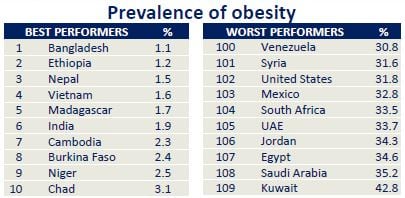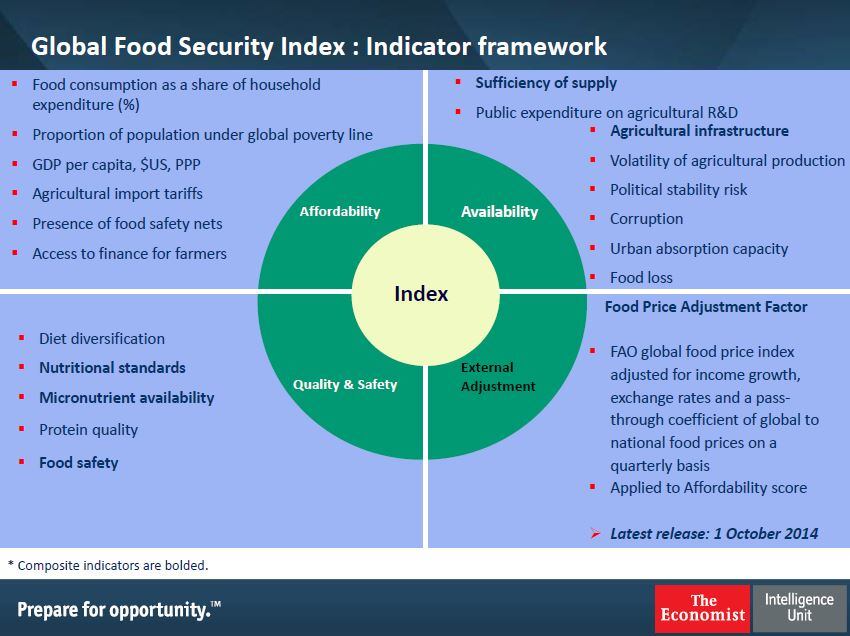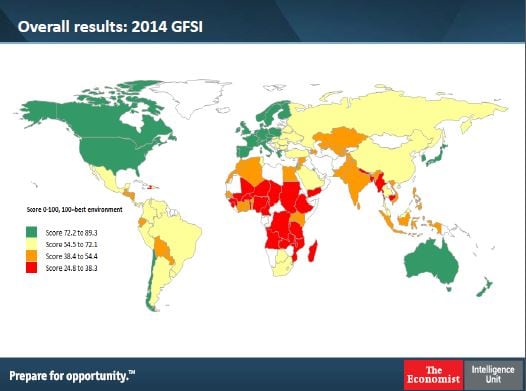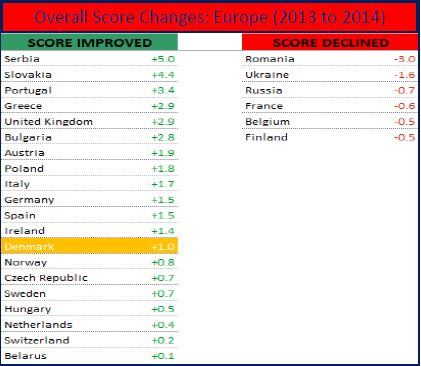Saudi Arabia (35.2%), Egypt (34.6%), Jordan (34.3%) and United Arab Emirates (33.7%) filled out the top 5. The update to the 3-year FSI was presented last week by Lucy Hurst from the Economist Intelligence Unit (EIU) at DuPont’s 50-year celebration of its Brabrand, Denmark, HQ. DuPont first commissioned EIU to produce an FSI in 2012 and the project is ongoing.
The FSI measures food security according to 28 criteria in 109 nations. Measures like food loss, nutrition and average food spend are grouped broadly under ‘affordability’, ‘availability’, ‘quality and safety’ as well as ‘external adjustments’.
The FSI’s carefully worded definition of food security states, “Food security exists when people at all times have physical, social and economic access to sufficient and nutritious food that meets their dietary needs for a healthy and active life.”
Prevalence of obesity
Hurst presented findings that showed, unsurprisingly, that the poorest countries had the lowest obesity levels. Bangladesh, Ethiopia, Nepal, Vietnam, Madagascar and India all had obesity levels below 2% of their populations.

The US – commonly thought to have the highest obesity levels – ranked only the 8th most obese at 102nd (31.8% obese).

“The correlation between food security and obesity is not always direct,” said Hurst.
“High rates of obesity are found in food secure populations in developing countries and less food secure populations in developed countries.”

When all 28 factors were considered the US had the world’s most secure food supply with a score of 89.3 out of 100. Next were Austria, the Netherlands, Norway, Singapore, Switzerland, Ireland, Canada, Germany, France and Denmark.
The least secure food security nations were almost all African: The Democratic Republic of the Congo, Chad, Madagascar, Togo, Burundi, Tanzania, Haiti, Niger, Mozambique and Burkina Faso.

Key findings
Other findings presented in Brabrant included:
- Food security improved for more than 70% of the 109 countries on the FSI.
- While sub-Saharan Africa had some of the world’s least secure food systems, countries there were also improving the most, gaining on average 2 points on the Index.
- Food consumption as a share of household expenditure averaged 43% in lower income countries versus 16% in high-income countries.
- Central and South American countries have the lowest agricultural import tariffs. The rate in Europe is 15.4%.
- 70% of the 109 nations have national dietary guidelines, a national nutrition plan or strategy, or monitor national nutrition.
- Europe and North America have the best access quality protein and some of the lowest for vegetal iron.
- Food loss is best in Finland (0.4% lost) and worst in Ghana (18.9% lost).
- Serbia was ‘most improved’ in Europe in food safety.

